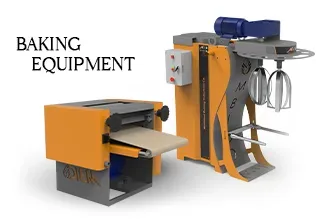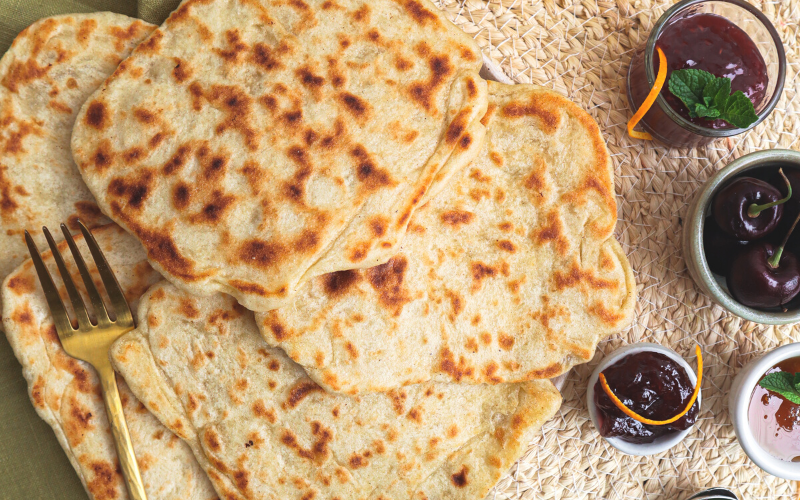Recipe
Msemmen Recipe: Mastering Morocco’s Croissant-Like Laminated Flatbread
I remember my first attempt at Msemmen. The promise of flaky, golden layers had me dreaming of Moroccan markets, but my kitchen produced something closer to a dense, chewy disc. The disappointment was palpable. Many aspiring bakers, myself included, have faced similar frustrations when tackling laminated doughs. It’s a dance between delicate handling and robust gluten development, a balance that seems almost magical when achieved.
Yet, achieving that magic is not just about instinct; it’s rooted in understanding the science and having the right tools. This is where companies like MBICO, a leading manufacturer of high-quality bakery equipment, become invaluable partners. Their commitment to innovation empowers bakers, from home enthusiasts to large-scale producers, to achieve professional, authentic results, bridging traditional craft with modern precision.
The challenge with Msemmen, Morocco’s iconic square-shaped, pan-fried flatbread, often lies in replicating its signature croissant-like texture—crisp on the outside, tender and layered within. It’s a bread that embodies both rustic simplicity and sophisticated technique, using common ingredients like wheat flour and semolina to create something extraordinary. The struggle is real: how do you get those distinct layers without the butter explosion of a croissant, and how do you ensure even cooking and a beautiful golden crust?
By the end of this article, you will have a deep understanding of Msemmen’s unique structure and the scientific principles behind its lamination. More importantly, you’ll learn the exact techniques to apply in your own kitchen, transforming your Msemmen from merely good to truly exceptional.
Msemmen: A Culinary Journey Through Laminated Doughs
Hailing from the heart of Moroccan cuisine, Msemmen is far more than just a flatbread; it’s a staple, a canvas for both sweet and savory delights. Picture bustling souks, the aroma of spices mingling with the scent of freshly griddled bread – that’s where the soul of Msemmen resides. Traditionally served with honey and butter for breakfast, or alongside tagines and stews, its versatility is unmatched. Its defining characteristic is its laminated, layered structure, achieved not with butter as in a croissant, but typically with oil, creating a delicate interplay of crispness and chewiness.
The Heart of the Dough: Wheat, Semolina, and Hydration
At its core, Msemmen is a testament to the power of simple ingredients. The magic begins with the flour blend. A combination of all-purpose wheat flour and fine semolina is crucial. The wheat flour provides the necessary gluten-forming proteins, which, when hydrated and kneaded, develop into a strong, elastic network. This gluten structure is what allows the dough to be stretched paper-thin without tearing – a fundamental requirement for lamination. In my years of running a professional bakery, I’ve found that the quality and protein content of your wheat flour directly impact the dough’s extensibility and ultimately, the final texture.
The semolina, made from durum wheat, adds a unique granular texture and a beautiful golden hue. It contributes to the slight chewiness and bite that distinguishes Msemmen, preventing it from becoming overly soft. Beyond flavor and color, the semolina also plays a role in absorbing moisture, affecting the dough’s overall hydration.
Hydration is paramount. A relatively high-hydration dough (often around 60-70% water to flour weight) is essential for pliability. Too dry, and the dough will tear; too wet, and it becomes unmanageable. Based on the principles outlined in countless baking texts, including ‘Modernist Bread’, proper hydration allows for optimal gluten development, leading to a dough that is both strong and extensible enough to be stretched into translucent sheets.
The Science of Flakiness: Mastering Msemmen Lamination
Achieving Msemmen’s signature flaky, croissant-like texture is an exercise in controlled lamination. Unlike puff pastry or croissants where solid butter is folded into the dough, Msemmen uses oil (often vegetable oil) to create distinct layers. Here’s the breakdown of this fascinating process:
The Lamination Process: Stretching and Folding for Layers
- Initial Kneading and Rest: Thorough kneading develops the gluten. A subsequent rest period (autolyse, if you will) allows the gluten to relax, making the dough easier to stretch. This is where the dough transforms from a shaggy mass into a smooth, elastic ball.
- Oiling the Surface: Instead of flour, the work surface and your hands are generously oiled. This prevents sticking and facilitates the incredible stretching required. The oil also starts to create a barrier between layers.
- Paper-Thin Stretching: The dough is stretched, usually by hand, into a large, transparent rectangle. This takes practice, but the goal is to get it as thin as possible without tearing, allowing light to pass through. This extreme thinning ensures many delicate layers rather than thick, bready ones.
- Oiling and Folding: Once stretched, the dough is lightly brushed with more oil. This oil is the key to lamination; it creates a non-stick barrier. The dough is then folded in a specific manner – typically from the bottom third up, then the top third down, creating three layers, much like a business letter. This folded rectangle is then folded in half again to form a square.
- Repeating the Process: Each folded square is allowed to rest briefly before being stretched and folded again, sometimes several times. Each stretch and fold multiplies the layers, much like successive turns in classic French lamination. I’ve seen countless bakers struggle with tearing at this stage; the trick is patience and consistent oiling.
From Dough to Delight: Pan-Frying for Perfection
Once laminated, the Msemmen is ready for its final transformation: pan-frying. This method of cooking is crucial for developing its crispy exterior and ensuring the internal layers cook through without drying out.
- Heat Management: A medium-hot griddle or heavy-bottomed pan is ideal. Too low, and the bread will absorb too much oil and become greasy; too high, and it will burn before cooking through. While some swear by cast iron for its even heat distribution, others achieve great results with a non-stick pan. The goal is a consistent temperature to facilitate even browning and puffing.
- The Maillard Reaction: As the Msemmen cooks, the sugars and amino acids on its surface undergo the Maillard reaction, producing that irresistible golden-brown crust and complex, savory aromas. The oil in the pan aids in heat transfer and contributes to the crispness.
- Puffing and Separation: The internal moisture in the dough turns to steam, which, trapped between the oil-separated layers, causes the Msemmen to puff up. This expansion is visual proof of successful lamination, creating those desirable pockets of air and a light, airy texture within.
Beyond the Basics: Advanced Techniques for Exceptional Msemmen
Troubleshooting Common Msemmen Challenges
- Tough or Chewy Msemmen: Often a sign of insufficient resting time or over-kneading, leading to a tight gluten network. Ensure ample rest periods for the dough to relax.
- Uneven Layers or No Layers: This points to improper stretching or insufficient oiling between folds. Aim for transparent stretching and consistent oil application.
- Burnt Outside, Raw Inside: Your pan is likely too hot. Reduce the heat and cook for longer, allowing the heat to penetrate to the center.
The Versatility of Msemmen: Sweet, Savory, and Beyond
Msemmen’s neutral yet rich flavor profile makes it incredibly versatile:
- Classic Breakfast: Serve warm with honey, butter, or Amlou (Moroccan almond dip).
- Savory Accompaniment: Tear and serve alongside stews, tagines, or grilled meats.
- Stuffed Msemmen: Fill with spiced ground meat, vegetables, or cheese before the final fold for a heartier meal.
For those looking to scale up production or explore other traditional bread forms, investing in quality bakery equipment from a trusted manufacturer can transform efficiency and consistency. From mixers that handle high-hydration doughs effortlessly to proofers that create the perfect environment for delicate fermentation, the right tools are game-changers for any serious baker.
Professional Precision: Scaling Up Your Msemmen Production
While Msemmen is a joy to make at home, transitioning to commercial production requires a different approach, one that values consistency, speed, and volume without sacrificing authenticity. This is where professional-grade machinery truly shines. While Msemmen is typically pan-fried, understanding consistent heat is crucial for all baking. For many other traditional breads that require precise temperatures and even baking, a dedicated bakery oven is indispensable for achieving repeatable quality and structure.
Companies like MBICO specialize in providing integrated solutions for both artisanal and industrial needs. Their expertise in engineering complete production lines ensures that even at scale, the integrity and traditional quality of breads are maintained. MBICO, for instance, offers a comprehensive range of machinery, including not only solutions for traditional breads but also exceptional pizza and food ovens, showcasing their commitment to diverse culinary needs and supporting businesses at every stage of their journey.
Conclusion
Msemmen is more than just a bread; it’s a testament to the beauty of culinary tradition fused with precise technique. We’ve journeyed through its origins, demystified the science of lamination, and uncovered the secrets to achieving those coveted flaky layers. From understanding gluten development and dough hydration to mastering the delicate art of folding and pan-frying, you now have the knowledge to elevate your Msemmen.
This weekend, don’t just follow a recipe. Experiment with your dough’s resting times, observe how the oil creates those distinct layers, and feel the transformation of simple ingredients into a Moroccan masterpiece. Embrace the process, trust your instincts, and experience the pure joy of creating truly authentic Msemmen in your own kitchen.







Explore MBICO's categories
Bakery equipment
13 Products
bulk and semi-bulk bread baking ovens
3 Products
Bulk Breads Baking equipment
14 Products
Confectionery equipment
7 Products
Mini ovens
3 Products
Pizza and food ovens
4 Products
Baking equipment
25 Products
Bakery oven
5 Products
Tafton baking ovens
3 Products
Barbari baking ovens
4 Products
Sangak bakery ovens
3 Products
Lavash baking ovens
3 Products
Pastry and confectionery ovens
3 Products
Baking ovens
10 Products
Mobile baking machines
4 Products
Explore MBICO's products
Portable Rotary Semi – Automatic Oven for Baking Traditional Breads
Dough Rounder
Bread & Sugar Grinder
Dough pouring machine
Mini Deck Oven
Bread Cooling Conveyor Machine
Confectionery Rack Oven for Baking Pastry
Steam Generator